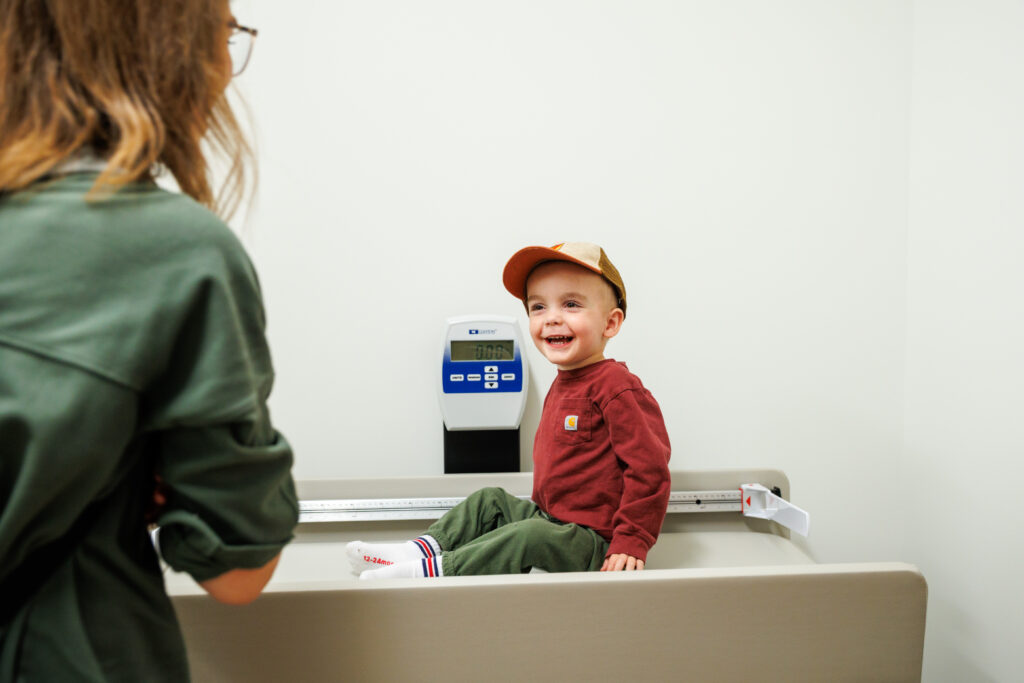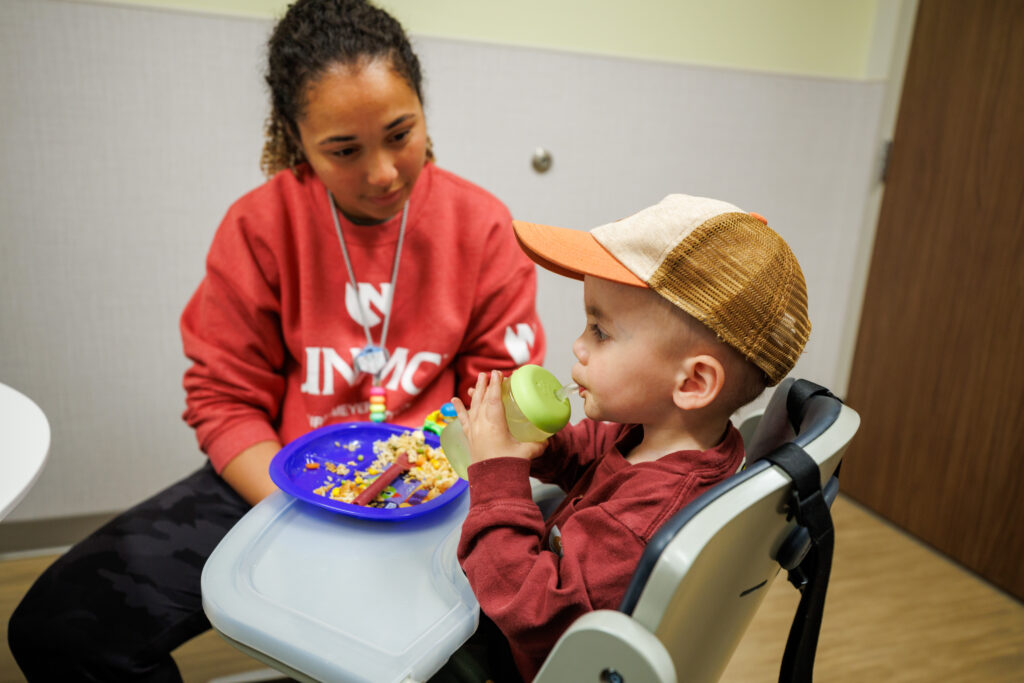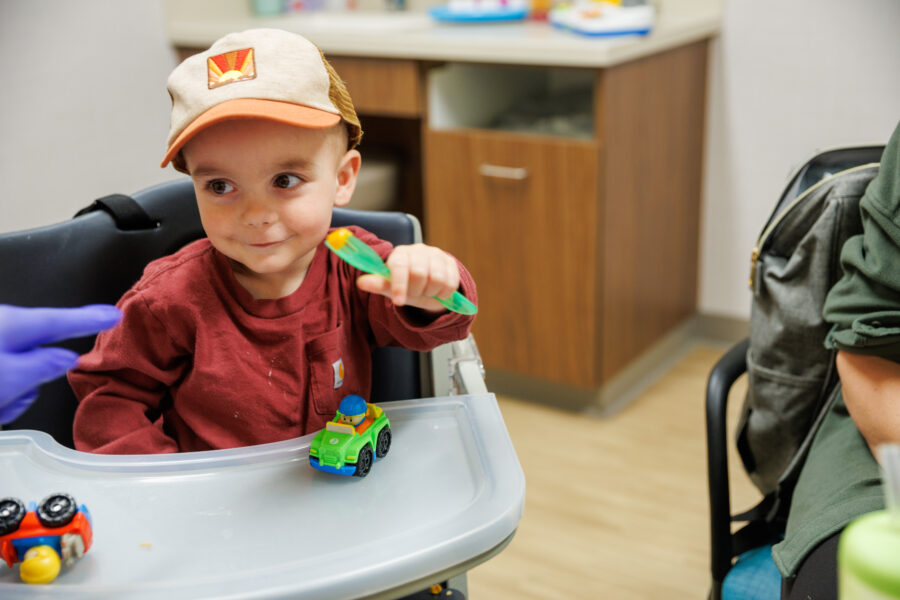Wade Welniak is a good passenger.
He spends car rides flipping through books, playing with toys and taking the occasional snooze.
The 2-year-old’s car skills come in handy during three-hour drives from his home in Ord, Nebraska, to the Munroe-Meyer Institute for pediatric feeding appointments.
Wade, who had been fully tube fed since he was 5 months old, now eats like his typical peers. His success is thanks to a new feeding co-treatment model with sessions led by both a speech therapist and dietitian.
Over the course of eight months, Wade went from being fully tube fed to taking all of his food orally. He did it all without weight loss or hunger-based weaning techniques, said Amy Volkman, registered dietitian with MMI’s Pediatric Feeding Department.

Many tube-weaning programs often see slow progress, such as multiple years of weekly therapy, Volkman said. If the tube-weaning is too aggressive, it can cause adverse outcomes like weight loss or malnutrition.
MMI’s new model uses evidence-based, individualized care that adapts to the child’s feeding skills and nutritional needs.
“Since both providers are present during sessions, we can collaboratively guide next steps, adjusting food or formula plans to support skill acquisition and overall health,” Volkman said.
Born early at nearly 28 weeks, Wade had a host of health issues. At home, it became apparent quickly that he wasn’t going to take food by mouth, his mom Alisha Welniak said.
The family saw local doctors to address his vomiting and reflux issues.
“They were at a loss for what to do,” Welniak said.
Then a social worker connected the family to MMI.
When Wade started the feeding program last June, he was completely tube fed. Now his last step is taking medications orally.
From the start, Sidni Trotter, a speech-language pathologist who works with Wade, looped in Amy Volkman, a registered dietitian and nutritionist in MMI’s Pediatric Feeding Department.
Wade had oral aversion and was vomiting multiple times a day, Volkman said. As a dietitian, Volkman changed the amount and timing of the formula Wade was receiving. That alleviated his gastrointestinal upset, allowing Trotter to see success in teaching Wade feeding skills.
For the first five or six sessions, Trotter used empty utensils to get Wade used to having things near and in his mouth. Then he passed a swallow study, letting the team know he could safely eat solids and drink liquids.
He started with water and pureed foods before progressing to foods with different textures.
Trotter and Volkman collaborated as Wade became more confident and able to eat different foods.
“He really took off when we timed using hunger cues after he acquired the skills to eat,” Volkman said. “He started to love food.”
Now Wade eats more than his two siblings at home, Welniak said.

At a recent appointment, Wade clambered into a high chair clutching a trio of toy cars. Trotter placed a plate of orange chicken and veggie fried rice in front of him, and Wade scooped up a bite on his spoon. He nodded in agreement with Trotter, Volkman and mom that the food was yummy.
“Good job,” Trotter told him. “I’m proud of you!”
The hybrid approach saw Welniak having to take feedback and implement the same strategies at home.
It takes effort and hard work for parents to change their feeding routines quickly, Volkman said.
“Honestly, we would not be this far if Mom did not put in os much work between sessions,” she added.
For Welniak, small milestones felt huge.
“Once it clicked, he was hungry,” Welniak said. “He had to learn that eating isn’t scary. It’s enjoyable. What MMI has done for Wade and our family means a lot.”
The process was tough, at times, and slow going. But there was light at the end of the tunnel, Trotter said. Wade will have one more in-person visit at MMI. Then he’ll come in on an as-needed basis.
“There were lots of tears to start,” Trotter said. “But this is exactly how we wanted to see him progress. It’s a testament, too, to mom’s ability to put things into a routine at home.”
Trotter and Volkman are happy with the results of the co-treatment model. Volkman compares it to a well-rehearsed dance.
“Each of us knows our steps, yet our shared goal is to teach both the child and the caregiver the rhythm and movements of the dance,” Volkman said. “We must move in harmony, responding to each other in real time and adjusting as needed without interrupting the flow.”
